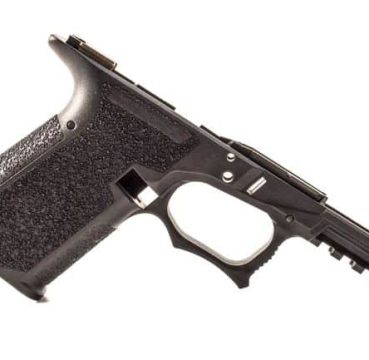In this article we’ll take an in depth look at the P80 Glock Frame. So many great features that may change Glock haters mind.
Table Of Contents
Why You Need a P80 Glock Frame
Glocks are among the most popular pistols ever produced, and today, the Glock 19 is actually the best selling pistol in the United States. There are many reasons why Glocks are incredibly popular today: they are simple, durable, reliable, and spare parts and accessories are in great abundance.
Nonetheless, not everybody loves Glocks. Those that dislike them almost always have the same complaints: the triggers are mushy, the sights leave a lot to be desired, and the grip angle does not feel very natural.
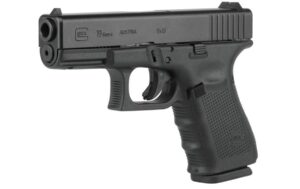
These are certainly fair criticisms. If a pistol doesn’t have the best trigger or if the grip doesn’t feel right in your hand, you can certainly pursue other options.
Nonetheless, Glocks are still simple, durable, and reliable. That doesn’t change. And furthermore, the issues of the poor trigger, grip angle, and substandard sights are things that you can easily remedy, and without sacrificing the inherent simplicity or reliability.
After installing a superior aftermarket trigger with the aid of a gunsmith, the way to solve the grip angle issue is to install what is called a Polymer80 frame (or referred to as a P80 Glock) on your Glock. The Polymer80 is a frame that is 80% complete, and has the same grip shape of a 1911 pistol, which is well known for its natural ergonomics and point ability.
That being said, since the Polymer80 Glock Frame is only 80% complete, it’s up to you to drill out pin holes and rail clearances before you can install it on your Glock.
Let’s discuss the P80 Glock frame in a bit more detail:
What You Need To Complete The P80 Glock Frame?
When the Polymer80 frame arrives, you will find it in a black box. Within the box will be the frame, along with a jig that will guide you to converting it into a full completed frame. Every bit that you need to drill the pin holes into the frame will be provided in the box, although you can also use a Dremel tool if you would like. Other lowing parts that will be provided are the locking block and the rails.
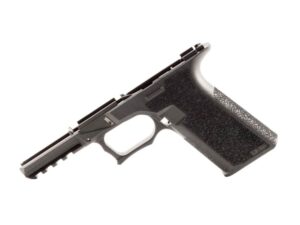
Please take note that when you are going to cut and drill into the frame, you need to do so extremely carefully, because you won’t be able to take back any mistakes you make. Once a hole has been drilled into the frame, it’s going to stay that way.
As far as tools are concerned, you are going to need a drill press that has a large end mill bit in order to properly remove material. In addition to the drill bits that are provided with the kit, you will additionally need a hand drill.
In addition, when working on the frame it will also be to your advantage to have a vice that can pivot (as this will make it far easier to work), as well as sandpaper that has at least 220 grit. The sandpaper is not totally necessary, but if you want to smooth out any rough edges, it will be of significant help.
Buying Additional Parts for Glock P80
You’re going to need to buy more parts beyond what is included in the Polymer80 kit. The Polymer 80 Frame is based off of the third generation of Glock pistols, which is why you will need to make sure that any lower and upper parts you get for your pistol will need to be Generation 3 compatible parts.
Generally speaking, all factory Glock generation 3 parts should work in the polymer 80 frame, and they should drop right in without you having to fit anything. The same goes for the upper slide assembly as well, but you don’t have to buy factory parts necessarily if you don’t want to. This is because you can alternatively go with other brands who make custom Glock parts, provided that they are all generation three compatible to. You may also want to go the extra mile and contact those companies to see if their products can specifically be used with P80 glock frames.
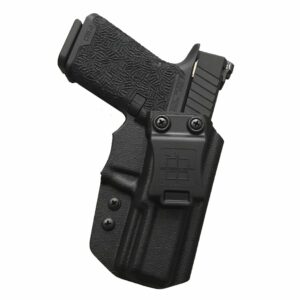
The one part or accessory that you are likely going to encounter at least a moderate amount of difficulty in finding compatibility with a P80 frame for is holsters, and particularly concealed carry holsters. You are going to need to find a holster that is explicitly designed for a P80 frame, which means that you’re going to need to do a lot more searching.
The reason a P80 frame requires its own unique holster rather than a standard Glock holster is because the trigger guard on the P80 frame is shaped a bit differently than a standard Glock trigger guard from the factory.
P80 Glock Key Features
There are many features that set the P80 frame far apart from the factory Glock frame.
The first and biggest key feature, by far, is the fact that the actual shape of the grip is far different in order to give it what many people consider to be superior ergonomics. One of the biggest complaints about the Glock pistol is that the grip, particularly on the larger models like the Glock 17 and Glock 34, is not very ergonomic and feels awkward. The P80 grip has a very similar shape to the 1911, which is a very natural and point able pistol.
This means that those who grew up shooting the 1911 pistols should find the P80 frame installed on their Glock to be far superior and natural.
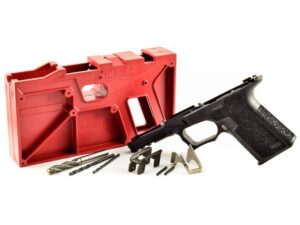
But the Glock P80 frame also comes with more ergonomic features, such as an undercut trigger guard, thumb ledges, a relief cut by the mag release, and a longer beavertail to help reduce slide bite and make the weapon much more pleasurable to shoot.
Glock Finger Groves?
The P80 frame also lacks the finger grooves that was a characteristic of generation three and generation four Glock frames.
Another big advantage to the P80 frame is the fact that it is available for all double stacked Glock pistols chambered in 9mm Luger and .40 S&W. This means the P80 frame can be installed on all of the following models, at minimum: 17, 17L, 19, 22, 23, 26, 27, and 34.
Last but not least, P80 kits are also very affordable. For a complete kit, you should expect to pay anywhere from a hundred twenty up to a hundred and sixty dollars.
Fixing Potential Issues With P80 Glock Frame
If you’re running into any issues with your Polymer80 kit, you can try any of the following fixes to these issues:
Parts Not Working – if there are any parts not working in your Polymer80 frame, replace all of the parts you installed with original manufacturer parts only. This is because there are many aftermarket parts that will have far too tight of tolerances to work in a P80 frame reliably.
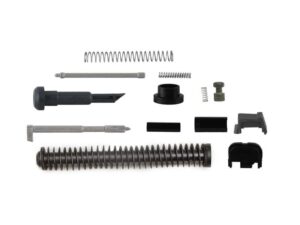
Trigger Issues: grind off a little bit from the polymer in the rear side rail. Each time you grind a bit more off, you will make the trigger better.
Stuck Slide –
When you first install a slide to your Polymer80 frame, you should notice some level of grit. This will smooth out the more you use the pistol and break it in.
That being said, if your slide becomes stuck, or if you are encountering bad difficulty in getting it installed on the first place, then you should check to see if the slide lock spring has snagged onto the recoil spring. This is almost always the culprit behind a stuck slide.
Holes Not Aligned –
Honestly, this is your bad if the holes are not lined up perfectly so the pins don’t go through evenly. Hopefully, you’ll be able to re-drill the frame in order to get the pins lined up. But if too much damage has already been caused, you will need to buy a new frame.
Conclusion
In conclusion, the Polymer80 frame is one of the best ways to make your Glock more ergonomic. Whether it’s a pistol that you’re going to be using for concealed carry, home defense, competition use, or just general range use.
The P80 frame is built to the same level of quality as a factory Glock frame. It is equally as functional and simple. That’s also not to mention that P80 frames are very affordable. So if you’re looking for a good upgrade without breaking the bank, it’s definitely a great way to go.
